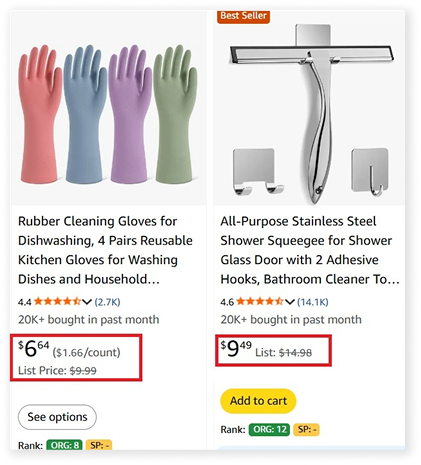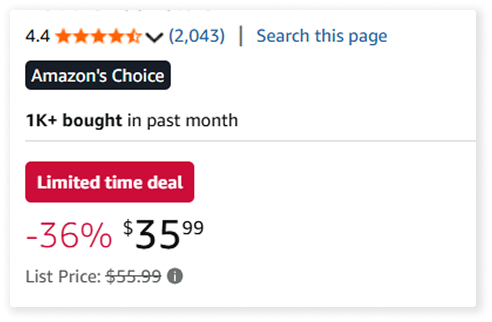Mastering Amazon Pricing, Promotions & Deals in 2025
Every brand has a pricing story.
But not every brand tells it strategically.
After years of testing, launching, and scaling thousands of products, we’ve learned one thing:
There’s no universal pricing formula.
Only continuous testing, data, and timing.
Let’s look at the pricing methods and deal types that truly shape growth on Amazon and how the latest updates affect your strategy today.
Strike-Through Price
A strike-through price shows the original retail price (RRP/MSRP) with a line through it and a lower price next to it.

It’s one of the strongest pricing signals you can use on Amazon.
At AMZ Bees, we adjust pricing for each product:
Three ways to get the strike-through price:
1. Sell one or more units at full (Recommended Retail Price) RRP before lowering the price
2. Let Amazon automatically match your website or marketplace prices
3. Request your SAS Core manager to connect your Amazon and website listings manually
💡 Tip: Since 2024, Amazon has verified all reference prices.
To display a strike-through price, your List Price must reflect real sales history. For non-seasonal products, this usually means sales or offers within the last 90 days, and 180 days for seasonal ones.
Coupons
Coupons are paid incentives that give shoppers an extra reason to buy.
They range from 5% to 50%, but not all bring real value

Our experience shows:
🆕 What’s new in 2025
United States:
Europe:
💡 Key insight: For cheaper items, lowering your base price might bring a better return than paying for a small coupon.
Promotions
Promotions such as “Buy one, get one free” or “Buy two, get a discount” are great visibility tools.
They don’t always bring direct revenue, but they keep shoppers longer on the PDP, which helps ranking.

Examples that work:
💡 Pro tip: Use promotions to enhance visibility and engagement, not only to drive sales.
Prime Exclusive Discounts (PED)
PEDs are free to create and available only to Prime members.
During major events like Prime Big Deal Days and T5 (Thanksgiving to Cyber Monday), the minimum discount is 20%.

At AMZ Bees, we rarely run PEDs outside these periods because they limit non-Prime shoppers.
During Prime Day or T5, however, they perform exceptionally well and can even outperform other paid promotion types.
🆕 Update for 2025:
During Prime events, the PED fee increased from $50 to $100, effective June 2, 2025.
Prime Day 2025 was extended to four days, giving brands a longer window for deal performance and visibility.
Lightning Deals
A Lightning Deal features your product on the Deals Page for 12 hours.
It brings additional traffic rather than immediate profit.

They work best when:
We often run them weekly or biweekly for high-performing products.
They drive new visitors that we later retarget through DSP.
💡 Lesson learned: Lightning Deals are momentum tools.
They help listings that already perform well grow faster.
Best Deals
Best Deals, previously known as 7-Day Deals, are limited-time offers designed to improve conversions and organic ranking rather than traffic.
They can be run once every month or two, depending on performance.

Our experience shows:
💡 New requirement: Your product must have a verified reference price and stay competitive once the deal ends.
In 2025, Amazon introduced the new Amazon Haul section, where selected Best Deals under $10 can appear.
Top Deals and Multi-Brand Top Deals (MBTD)
Top Deals are selected manually by Amazon’s internal team.
They appear at the top of the Deals Page and sometimes even on the homepage.
To qualify, your product needs strong sales velocity, excellent visuals, and competitive pricing.

We have reached Top Deal status only through SAS Core and Launchpad managers.
In one case, sales jumped from $26K to $434K in a single day.
MBTDs are easier to access but deliver lower results since multiple brands share one card.
💡 Pro insight: If your Top Deal performs above expectations, Amazon may invite you again within three months. Underperforming deals will delay the next opportunity.
Bringing It All Together
Pricing, coupons, and deals work best when connected with advertising.
They should serve one purpose - to move your metrics in the right direction.
Sometimes, increasing your price before a deal creates a stronger perceived discount.
Sometimes skipping a deal keeps your profit stable.
Always measure ranking movement and conversion rate after every promotion.
Final Thoughts
Amazon keeps evolving how pricing and promotions work.
Coupon fees, reference price rules, and deal structures continue to change.
What doesn’t change is the need to test, measure, and adapt.
At AMZ Bees, we’ve tried it all: Lightning Deals, Top Deals, Best Deals, launch coupons, and pricing experiments across every category.
Each product behaves differently.
The only real rule is simple:
Experiment until you find what wins in your niche.
Every brand has its own formula. What’s yours?




